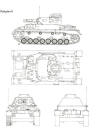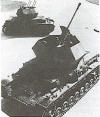|
|
Panzer PzKpfw Mk IV |
|
Panzer Mk
IV History
Origins
The first orders for a design that was to become the PzKpfw IV were issued
in 1934. Three firms built prototypes, but the Krupp submission, which was
designated VK2001, was given the production contract in 1936. As things
turned out the final production version was a combination of features from
both the Krupp and Rheinmetall designs. The project intention was
disguised by the appellation of 'battalionsfuhrerswagen' (battalion
commander vehicle), and production began in 1937 after extensive trials.
Models
PzKpfw IV Ausf A
It is a tribute to the sound basic design of the PzKpfw IV that the
first production vehicle was essentially the same basic vehicle as the
last tank to roll off the production line. Between 1937 and 1945 the
PzKpfw IV was fitted with more powerful guns and thicker armour but the
suspension and drive systems remained unchanged. 35 Ausf A tanks were
built and all were fitted with the short 7.5 cm gun that made the PzKpfw
IV one of the most heavily armed tanks of its day.
PzKpfw IV Ausf B
This model differed from the Ausf A in detail only — for example the
cupola was revised and the hull front was simplified.
PzKpfw IV Ausf C More small design
changes were added to produce the Ausf C, the most prominent of which was
the addition of a sleeve to protect the turret machine-gun. The engine was
also changed.
PzKpfw IV Ausf D In 1940 the Ausf D
was introduced which incorporated for the first time the sloped roof to
the hull front roof. Other changes were made to the track and a more
powerful engine was installed.
PzKpfw IV Ausf E This model was
intended as an interim model only, pending the production of the Ausf F.
Extra armour was fitted and many details intended for the Ausf F were
incorporated.
PzKpfw IV Ausf F The Ausf F was
intended to be the main production variant of the PzKpfw IV but it was
soon overtaken by events as the short L/24 gun was replaxed by an L/43
version. With this change the PzKpfw IV was no longer a support tank for
other forces but it became an excellent fighting tank and was used as such
from 1941 onwards, superceding the PzKpfw III. Later this version was
redesignated the F1 as an even better gun was installed.
PzKpfw IV Ausf F2 The early Ausf F
model fitted with the short L/24 gun was later retrofitted with the longer
L/43 version, and in time with the later L/48 weapon. It was used in large
numbers and saw service on all fronts, including the Western Desert.
PzKpfw IV Ausf G This model was
basically the same as the Ausf F2 but had thicker armour. The Ausf G was
the first model to be fitted with 'Scheutzen' side armour.
PzKpfw IV Ausf H With the introduction
of the Ausf H in 1943, the PzKpfw IV took on a new lease of life, for it
was fitted with the potent 7.5 cm KwK 40 L/48. With this gun the PzKpfw IV
was able to take on almost any tank, and was thus able to retain its
placing in the panzer divisions. Changes to help in speeding production
were made and 'scheutzen' were standard.
PzKpfw IV Ausf J The Ausf J was the
last production model and appeared in 1944. By that time many raw
materials and processes were difficult to obtain, and this was visible in
the use of wire mesh 'scheutzen' in place of the usual steel plates. Many
other changes had to be made to simplify the design but it remained
basically unchanged from earlier models.
As the PzKpfw IV was produced in larger numbers than any other German tank
it is not surprising that it was much used for many other tasks apart from
that of battle tank. The listing below can only mention the more common
tasks that the PzKpfw IV chassis had to perform.
Variants
As the PzKpfw IV was produced in larger numbers than any other German tank it is not suprising that it was much used for many other tasks apart from that of battle tank. The listing below can only mention the more common tasks that the PzKpfw IV chassis had to perform.
Jagdpanzer IV Ausf F
One of the most successful of all the PzKpfw IV variants was the
Jagdpanzer IV. This was a conversion of a standard PzKpfw IV chassis to
take a low fighting compartment with well-sloped armour. Armament was the
7.5 cm StuK L/48. This version had the SdKfz number 162 but a later
variant with an L/70 gun became the SdKfz 162/1. This later variant was
more cumbersome than the version with the L/48 gun and was more difficult
to handle, but it was pressed into service as 'it was the Fuhrer's will'.
A later variant still was the 'Zwischenlosung' which was the addition of a
Jagdpanzer IV superstructure mounted direct onto a PzKpfw IV chassis. In
all its forms the Jagdpanzer IV was " a formidable opponent and an
effective tank-killer.
Sturmgeschutz IV (SdKfz 163) In 1943
some spare capacity was found which was able to turn out PzKpfw IV
chassis, and this was utilised for a time in a strange conversion in which
StuG III superstructures were added to the PzKpfw IV chassis. The result
was the StuG IV which served alongside the StuG III. Many of these
vehicles carried extra concrete armour.
Sturmpanzer IV Brummbar (Grizzly Bear)
The German experiences in such cities as Stalingrad and Leningrad
convinced the Germans that they needed a specialised vehicle for street
fighting. They added a heavily armoured compartment to a PzKpfw III
chassis and armed it with a 15 cm L/12 gun — the result was the Brummbar.
Ausf F, G, H and J vehicles were used and the Brummbar was produced in
some numbers with several variations.
Panzerjager III/IV Nashorn or Hornisse (Rhinocerous
or Hornet) (SdKfz 164) In 1942 the need for a heavy anti-tank
gun was desperate and a typical German improvisation emerged in the shape
of a PzKpfw IV chassis with PzKpfw III drives, mounting an 8.8 cm Pak 43/1
gun. The result was high and rather awkward but it worked and was produced
in some numbers pending better equipment.
Flakpanzer IV There were several
variations of Flakpanzer IVs. One mounted a four-barrel 20 mm Flak-vierling
38 on an open platform, another the same gun in an enclosed turret, and
two others mounted a single 3.7 cm Flak 43 gun — again, one on an open
platform and the other in a turret. These vehicles, known as the
Mobelwagen (Furniture Van), Ost-wind (East Wind) and Wirbelwind
(Whirlwind), were used to give some form of anti-aircraft defence to
armoured units.
Geschtitzwagen III/IV Hummel (Bumble Bee) (SdKfz
165) This was another PzKpfw III/IV vehicle, this time used to
mount the 15 cm schwere Panzerfeldhaubitze 18/1 field piece. First
produced in 1942, the Hummel was manufactured in large numbers.
On the Russian front many old PzKpfw IV tanks had their turrets removed
and replaced by a flat platform or truck platform. They were then used as
supply vehicles. Some were used as engineer vehicles carrying bridging
equipment, and others were used as armoured recovery vehicles.
Technical Specification
Mk IV Variations & Plans
|
Plans |
Mk IV Ausf E | Mk IV Ausf H | MK IV D | MK IV Flackpanzer |
 |
 |
 |
 |
 |
| Specifications | Ausf C | Ausf F2 | Ausf J |
| No Image |
No Image |
||
| Weight | 20 Tons | 23.6 Tons | 25 Tons |
| Max Road Speed | 40 kph / 24.8 mph | 40 kph / 24.8 mph | 38 kph / 23.6 mph |
| Road range | 200 km / 124 miles | 200 km / 124 miles | 300 km / 186 miles |
| Cross Country Range | 130 km / 80.7 miles | 130 km / 80.7 miles | 180 km / 111.5 miles |
| Length Overall | 5,870 mm / 231 inches | 6,630 mm / 261 inches | 7,020 mm / 276 inches |
| Width | 2,850 mm / 112 inches | 2,880 mm / 113.4 inches | 3,290 mm / 129.5 inches |
| Height | 2,590 mm / 102 inches | 2,680 mm / 105.5 inches | 2,680 mm / 105.5 inches |
| Engine | 300 Horse power | 300 Horse power | 300 Horse power |
| Track Width | 380 mm / 15 inches | 400 mm / 15.75 inches | 560 mm / 22 inches |
| Wheel base | 2,620 mm / 103 inches | 2,620 mm / 103 inches | 2,620 mm / 103 inches |
| Armament 1 | 1 x 7.5 cm L/24 |
1 x 7.5 cm L/24 |
1 x 7.5 cm L/24 |
| Armament 2 | 2 x 7.92 mm MG | 2 x 7.92 mm MG | 2 x 7.92 mm MG |
| Ammunition Carried 1 | 80 x 7.5 cm | 87 x 7.5 cm | 87 x 7.5 cm |
| Ammunition Carried 2 | 2,700 x 7.92 mm | 3,150 x 7.92 mm | 3,150 x 7.92 mm |
| Bow Armour | 30 mm / 1.18 inches | 30 + 30 mm / 1.18 + 1.18 inches | 80 mm / 3.15inches |
| Side Armour | 14.5 mm / 0.57 inches | 20 + 20 mm / 0.78 + 0.78 inches | 30 + 5 mm / 1.18 + 0.2 inches |
| Roof & Floor Armour | 11 mm / 0.43 inches | 11 mm / 0.43 inches | 16 mm / 0.63 inches |
| Turret Armour | 30 mm / 1.18 inches | 50 mm / 1.97 inches | 50 mm / 1.97 inches |
| Crew | 5 | 5 | 5 |


